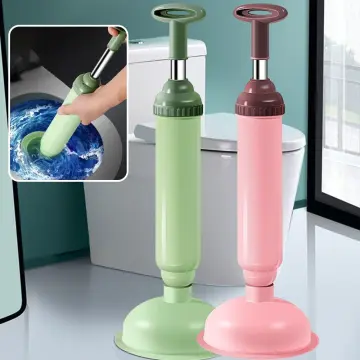Tips to Learn Plunger and Drain Cleaners: Specialist Tips
Tips to Learn Plunger and Drain Cleaners: Specialist Tips
Blog Article
What are your thoughts regarding How to Unclog Your Sink with a Plunger?

Intro
Appropriate maintenance of house drains is important for preventing blockages and making sure smooth water flow. One of the trick devices in every property owner's toolkit is the bettor, together with various drainpipe cleaners designed to deal with stubborn obstructions efficiently. This write-up checks out just how to utilize bettors and drain cleansers effectively to maintain your drains pipes flowing easily.
Section 1: Comprehending Bettors
Sorts of Plungers
There are numerous types of plungers offered, each made for different kinds of drains and blocks. The most usual types consist of mug plungers, flange bettors, and accordion plungers.
How Plungers Job
Plungers work with the principle of developing pressure and suction to dislodge blockages. When correctly used over a drain, they produce a vacuum that can pull out particles or break up obstructions.
Choosing the Right Plunger
Picking the right plunger relies on the type of drain and the nature of the obstruction. Mug bettors are suitable for sinks and bathtubs, while flange plungers are better matched for bathrooms as a result of their style.
Usual Errors with Bettors
Avoiding these mistakes makes certain efficient plunging: improper seal around the drainpipe, inadequate pressure, and unclear surrounding particles.
Section 2: Making Use Of Plungers Properly
Preparation
Prior to plunging, make certain the plunger covers the drainpipe completely and develops a tight seal. Clear any type of noticeable debris around the drainpipe opening.
Technique
Begin with mild plunging movements to build suction. Boost stress progressively, using a stable rhythm. Repeat as needed up until the drainpipe gets rid of.
Repairing Tips
If plunging does not work, try adjusting the seal, applying oil jelly for a far better seal, or utilizing a different type of bettor.
Area 3: Comprehending Drain Cleaning Company
Kinds Of Drain Cleaning Company
Drain pipes cleaners can be chemical or chemical. Chemical cleaners use solid chemicals to dissolve obstructions, while enzymatic cleansers use all-natural enzymes to break down organic matter.
Just How Drain Cleaning Company Work
Chemical cleansers react with blockages to liquify them, while enzymatic cleansers break down natural materials like hair and oil without harming pipes.
Safety and security Considerations
Always use gloves and eye defense when utilizing chemical drain cleansers. Make sure adequate air flow and comply with supplier directions thoroughly.
Eco-Friendly Alternatives
Consider utilizing vinegar and baking soda or enzyme-based cleansers for environment-friendly options that are much safer for pipelines and the atmosphere.
Area 4: Using Drain Cleaning Company Effectively
Application Methods
Put chemical cleansers directly into the drain opening. Permit them to benefit the advised time before purging with hot water. Enzymatic cleansers should sit overnight.
Precautions
Avoid mixing different kinds of cleansers, as this can create poisonous fumes. Never ever make use of chemical cleansers in conjunction with a plunger, as splashing can occur.
Dealing With Stubborn Clogs
For persistent clogs, take into consideration making use of a pipes serpent or calling an expert plumbing to prevent damages to pipelines.
Final thought
In conclusion, understanding just how to utilize plungers and drainpipe cleaners effectively is essential for keeping healthy pipes systems. By selecting the right tools and strategies, property owners can take on minor obstructions and stop major plumbing concerns down the line.
How To Properly Use A Plumbing Snake To Clear Drains
When any drain clogs in our home arise, we tend to gravitate toward the plunger and little else. In cases where the plunger and its vacuum-created pressure are not able to clear clogs, many immediately move to harmful chemicals or simply call their plumber to fix the issue.
we’re happy to help with all drain cleaning needs and concerns. This includes informing you on a few other home remedies you may have at your disposal for minor to moderate clogs, one of which is the use of a plumbing snake. Many people have never used one of these before – let’s go over the steps to take when your drain clogs and you have a plumbing snake available.
Attempt Plunger Use
The first step here, as we noted above, should indeed be to grab your plunger when you notice a drain clog and attempt to resolve it this way. If you’re unsure how to use a particular type of plunger, our plumbers can answer any questions you have. If this doesn’t do the trick, however, you move on to the snake.
Locate And Prepare Snake
A plumbing snake is a metal or plastic device that’s generally about a quarter of an inch thick. It’s design with significant extensions, meant to reach down into your clogged drain and push the clog out. Snakes also contain drain augers that will latch onto and push stubborn blockages.
If your plunger doesn’t clear a clog, locate your snake and bring it to the drain in question. We also recommend keeping a bucket nearby to collect the clog once you pull it out, plus we’d advise wearing goggles and possibly protective gloves.
Feed Snake
Once you’re ready to go, feed the snake slowly down the drain, using the crank device it comes with to keep it moving until it finds the clog. Once this happens, much of the clog will be latched onto the coil so you can pull it out, while the rest will simply break up and flow downward.
Detach Debris
Remove the snake slowly from the drain, and once you’ve done so, pick off any debris that’s stuck to the coil. This is another area where wearing gloves is a must.
Flush Drain
Finally, take a few minutes to ensure the snake has done its job correctly. If you’ve been using it on a toilet, flush the toilet a couple times and make sure everything flows well. If you’ve used it on a different drain, flush it with some room temperature water.
https://www.mybuddytheplumber.com/blog/how-to-properly-use-a-plumbing-snake-to-clear-drains/

Application Methods
Put chemical cleansers directly into the drain opening. Permit them to benefit the advised time before purging with hot water. Enzymatic cleansers should sit overnight.
Precautions
Avoid mixing different kinds of cleansers, as this can create poisonous fumes. Never ever make use of chemical cleansers in conjunction with a plunger, as splashing can occur.
Dealing With Stubborn Clogs
For persistent clogs, take into consideration making use of a pipes serpent or calling an expert plumbing to prevent damages to pipelines.
Final thought
In conclusion, understanding just how to utilize plungers and drainpipe cleaners effectively is essential for keeping healthy pipes systems. By selecting the right tools and strategies, property owners can take on minor obstructions and stop major plumbing concerns down the line.
How To Properly Use A Plumbing Snake To Clear Drains
When any drain clogs in our home arise, we tend to gravitate toward the plunger and little else. In cases where the plunger and its vacuum-created pressure are not able to clear clogs, many immediately move to harmful chemicals or simply call their plumber to fix the issue.
we’re happy to help with all drain cleaning needs and concerns. This includes informing you on a few other home remedies you may have at your disposal for minor to moderate clogs, one of which is the use of a plumbing snake. Many people have never used one of these before – let’s go over the steps to take when your drain clogs and you have a plumbing snake available.
Attempt Plunger Use
The first step here, as we noted above, should indeed be to grab your plunger when you notice a drain clog and attempt to resolve it this way. If you’re unsure how to use a particular type of plunger, our plumbers can answer any questions you have. If this doesn’t do the trick, however, you move on to the snake.
Locate And Prepare Snake
A plumbing snake is a metal or plastic device that’s generally about a quarter of an inch thick. It’s design with significant extensions, meant to reach down into your clogged drain and push the clog out. Snakes also contain drain augers that will latch onto and push stubborn blockages.
If your plunger doesn’t clear a clog, locate your snake and bring it to the drain in question. We also recommend keeping a bucket nearby to collect the clog once you pull it out, plus we’d advise wearing goggles and possibly protective gloves.
Feed Snake
Once you’re ready to go, feed the snake slowly down the drain, using the crank device it comes with to keep it moving until it finds the clog. Once this happens, much of the clog will be latched onto the coil so you can pull it out, while the rest will simply break up and flow downward.
Detach Debris
Remove the snake slowly from the drain, and once you’ve done so, pick off any debris that’s stuck to the coil. This is another area where wearing gloves is a must.
Flush Drain
Finally, take a few minutes to ensure the snake has done its job correctly. If you’ve been using it on a toilet, flush the toilet a couple times and make sure everything flows well. If you’ve used it on a different drain, flush it with some room temperature water.
https://www.mybuddytheplumber.com/blog/how-to-properly-use-a-plumbing-snake-to-clear-drains/

I recently found that entry on Tips on How to Effectively Use a Plunger when browsing the search engines. Loved our posting? Please share it. Help somebody else discover it. Thank you for your time invested reading it.
About Report this page